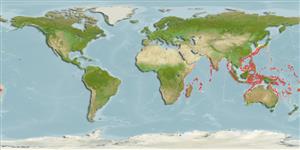Environment: milieu / climate zone / depth range / distribution range
Ecologia
marino demersale; distribuzione batimetrica 150 - 278 m (Ref. 44037). Deep-water
Indo-West Pacific: including Japan.
Size / Peso / Age
Maturity: Lm ? range ? - ? cm
Max length : 11.4 cm SL maschio/sesso non determinato; (Ref. 11148)
Spine dorsali (totale) : 0; Raggi dorsali molli (totale) : 85 - 97; Spine anali: 0; Raggi anali molli: 71 - 81; Vertebre: 40 - 42. Pelvic fin on ocular side slightly elongate, extending to near the tip of the isthmus, the distance between the tip of the isthmus and the insertion of the pelvic fine subequal to the length of the pelvic fin base. Second ray of the pelvic fin on ocular side opposite to the 1st on the blind side. In male, the 12th to 18th dorsal rays and the 1st to 8th anal rays greatly elongated into filaments (Ref. 559). Soft ray count of pectoral fin refers to that on ocular side.
Life cycle and mating behavior
Maturità | Riproduzione | Deposizione | Uova | Fecundity | Larve
Masuda, H., K. Amaoka, C. Araga, T. Uyeno and T. Yoshino, 1984. The fishes of the Japanese Archipelago. Vol. 1. Tokai University Press, Tokyo, Japan. 437 p. (text). (Ref. 559)
IUCN Red List Status (Ref. 130435: Version 2024-1)
Threat to humans
Harmless
Human uses
Strumenti
Special reports
Download XML
Fonti Internet
Estimates based on models
Preferred temperature (Ref.
123201): 13.8 - 21.4, mean 16.9 °C (based on 86 cells).
Phylogenetic diversity index (Ref.
82804): PD
50 = 0.7500 [Uniqueness, from 0.5 = low to 2.0 = high].
Bayesian length-weight: a=0.00912 (0.00408 - 0.02036), b=3.04 (2.85 - 3.23), in cm total length, based on LWR estimates for this (Sub)family-body shape (Ref.
93245).
Trophic level (Ref.
69278): 3.5 ±0.4 se; based on size and trophs of closest relatives
Resilienza (Ref.
120179): Medio, tempo minimo di raddoppiamento della popolazione 1.4 - 4.4 anni (Preliminary K or Fecundity.).
Fishing Vulnerability (Ref.
59153): Low vulnerability (10 of 100).
